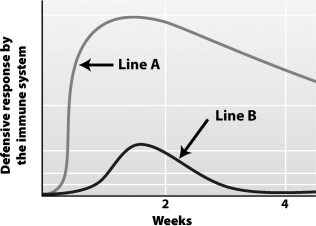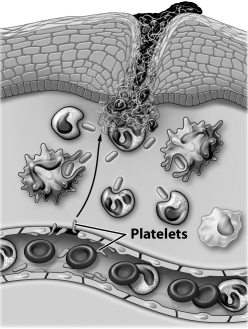A) phagocytosis.
B) producing antigens.
C) producing antibodies.
D) encapsulation.
Correct Answer

verified
Correct Answer
verified
Short Answer
The ____________________ immune system is a specific defense against parasites and internal diseases that exists only in vertebrate animals.
Correct Answer

verified
Correct Answer
verified
True/False
Adaptive immune responses are faster at responding to the invasion of a pathogen than innate immune responses.
Correct Answer

verified
Correct Answer
verified
True/False
White blood cells called macrophages destroy invading pathogens by phagocytosis.
Correct Answer

verified
Correct Answer
verified
Short Answer
____________________ blood cells are a kind of defensive cell found in the interstitial fluid between the cells in the most vulnerable parts of the body and circulating in the blood.
Correct Answer

verified
Correct Answer
verified
Short Answer
The graph below depicts the immune response following a vaccine and a booster shot.  The line labeled with the letter ____________________ represents the response after the initial vaccine.
The line labeled with the letter ____________________ represents the response after the initial vaccine.
Correct Answer

verified
Correct Answer
verified
Short Answer
At various points along the lymphatic ducts lie ____________________, pockets of tissue containing huge numbers of white blood cells that trap bacteria, viruses, and foreign proteins.
Correct Answer

verified
Correct Answer
verified
Multiple Choice
At the site of a wound or cut, platelets combine with proteins in our blood to form
A) macrophages.
B) antibodies.
C) prostaglandins.
D) clots.
Correct Answer

verified
Correct Answer
verified
True/False
Macrophages are smaller than neutrophils but have a similar function.
Correct Answer

verified
Correct Answer
verified
Multiple Choice
The human immune system contains trillions of specialized cells of several kinds, all of which help destroy invaders. What are these cells called?
A) red blood cells
B) white blood cells
C) lymphatic cells
D) blood plasma
Correct Answer

verified
Correct Answer
verified
Multiple Choice
Which of the following statements about infection by HIV, the virus that causes AIDS, is false?
A) Most AIDS victims go through a period of up to 15 years between infection and the onset of AIDS symptoms.
B) In the early part of the infection, killer T lymphocytes destroy helper T lymphocytes infected by the virus.
C) The antigens on the protein coat of the HIV remain the same through time.
D) The victim's immune system eventually collapses, and normally harmless infections cause death.
Correct Answer

verified
Correct Answer
verified
Multiple Choice
Memory cells
A) include B and T cells that remain in the body for long periods of time after the first exposure to a pathogen.
B) are macrophages that store copies of antibodies for decades.
C) make copies of T cells that remain active long after the primary response has ended.
D) become T cells during a secondary response to a pathogen.
Correct Answer

verified
Correct Answer
verified
Multiple Choice
Which of the following statements about vaccinations given to humans is true?
A) The vaccination acts as the first exposure to a virus, allowing the much more effective second exposure response to occur when the virus actually infects the body.
B) A vaccination primes the body so that it will no longer respond to an invasion by a virus.
C) There is a chance of a person's getting the disease from a vaccination, because vaccination involves the injection of the entire living disease organism.
D) Vaccinations prime the virus so that the virus will not kill as many body cells as it would in a nonvaccinated person.
Correct Answer

verified
Correct Answer
verified
Multiple Choice
The image below depicts 
A) adaptive immunity: antibodies are being made.
B) passive immunity: neutrophils are being destroyed.
C) innate immunity: memory cells are being made.
D) inflammatory response: blood vessels are porous and leaking fluid.
Correct Answer

verified
Correct Answer
verified
Short Answer
A vaccine stimulates the formation of ____________________ cells by introducing the immune system to a killed or weakened form of a virus before they are exposed to the actual pathogen.
Correct Answer

verified
Correct Answer
verified
Multiple Choice
An example of innate immunity component involves
A) the production of antibodies from T cells.
B) the production of antibodies from B cells
C) vaccinations.
D) the acidic environment in the digestive system.
Correct Answer

verified
Correct Answer
verified
True/False
In the case of AIDS, death is more likely to result from other infections that the immune system cannot control than from HIV itself.
Correct Answer

verified
Correct Answer
verified
Multiple Choice
Why is it important that white blood cells are able to travel outside the human circulatory system?
A) To form a complement, white blood cells must leave the circulatory vessels.
B) White blood cells are the antibodies that target parasites.
C) Pathogens may be found in areas of the body other than within circulatory vessels.
D) White blood cells must leave the circulatory system in order to return red blood cells to the circulatory vessels.
Correct Answer

verified
Correct Answer
verified
Multiple Choice
Complement proteins
A) kill invaders.
B) are precursors to antibodies.
C) repel macrophages.
D) break down antigens.
Correct Answer

verified
Correct Answer
verified
True/False
When an item irritates the eyes, tears form in order to release lysozyme enzymes.
Correct Answer

verified
Correct Answer
verified
Showing 21 - 40 of 78
Related Exams